New Zealand has a whole host of weird and wonderful creatures that exist nowhere else in the world. Many are endangered, so seeing them in the wild is a real privilege. Here is a list of ten New Zealand beasts, each fantastic in its own way, along with the best places to find them in the wild.

1) KIWI
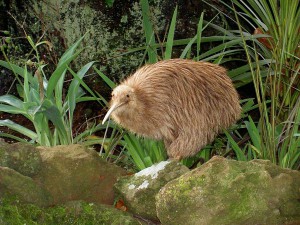 Kiwis are strange. (The birds, not the people of New Zealand.) For starters, they think they’re mammals. Flightless, with wings reduced by evolution to a pair of invisible stumps, they roam the forest floor at night like badgers – they even have whiskers and build burrows. Their feathers have become like fur; their bones filled with marrow. Their nostrils are at the ends of their long beaks, rather than at the top, and they can live until they are fifty years old. When kiwis run, it’s hilarious. They have no tail to balance themselves – they’re basically fat, fluffy balls on stumpy legs. The other peculiar thing about the kiwi is its egg: it’s enormous, about a quarter of the female’s body weight – imagine giving birth to that! The best place to see kiwis in the wild is on Stewart Island.
Kiwis are strange. (The birds, not the people of New Zealand.) For starters, they think they’re mammals. Flightless, with wings reduced by evolution to a pair of invisible stumps, they roam the forest floor at night like badgers – they even have whiskers and build burrows. Their feathers have become like fur; their bones filled with marrow. Their nostrils are at the ends of their long beaks, rather than at the top, and they can live until they are fifty years old. When kiwis run, it’s hilarious. They have no tail to balance themselves – they’re basically fat, fluffy balls on stumpy legs. The other peculiar thing about the kiwi is its egg: it’s enormous, about a quarter of the female’s body weight – imagine giving birth to that! The best place to see kiwis in the wild is on Stewart Island.
2) KEA
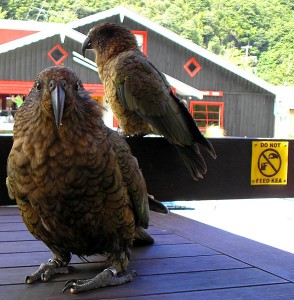 The kea is the world’s only alpine parrot – that’s a parrot that lives in the snow! It’s also one of the most intelligent animals on the planet. This makes them highly amusing creatures to observe, (although the tourist who returns to their rental car to find the windscreen wipers ripped off is never quite so amused.) Rather appropriately, a group of keas is called a circus. They’re extremely curious and will investigate anything for food or for the fun of it. When my family was on a South Island campervan tour, we stopped at a café that had a sign telling people not to feed the keas, but they didn’t need any encouraging – they were on the tables knocking over coffee cups to drink the dregs, snatching the unguarded muffin and generally observing the behaviour of the humans, no doubt hatching plans for world domination. There was a toddler in a high chair that was banging its food tray up and down and, after the family had left, a kea climbed into the high chair and started banging the tray up and down for itself! Keas can be found all over the mountainous regions of the South Island, but that café was in Arthur’s Pass.
The kea is the world’s only alpine parrot – that’s a parrot that lives in the snow! It’s also one of the most intelligent animals on the planet. This makes them highly amusing creatures to observe, (although the tourist who returns to their rental car to find the windscreen wipers ripped off is never quite so amused.) Rather appropriately, a group of keas is called a circus. They’re extremely curious and will investigate anything for food or for the fun of it. When my family was on a South Island campervan tour, we stopped at a café that had a sign telling people not to feed the keas, but they didn’t need any encouraging – they were on the tables knocking over coffee cups to drink the dregs, snatching the unguarded muffin and generally observing the behaviour of the humans, no doubt hatching plans for world domination. There was a toddler in a high chair that was banging its food tray up and down and, after the family had left, a kea climbed into the high chair and started banging the tray up and down for itself! Keas can be found all over the mountainous regions of the South Island, but that café was in Arthur’s Pass.
3) TUATARA
The tuatara is the only surviving member of a group of reptiles older than the dinosaurs. This makes the species a ‘living fossil’ and, as such, it is of great importance to biologists. They live their lives at a very slow place. They don’t reach sexual maturity until they’re at least ten years old and keep growing until they’re about thirty-five. Some say that they can live for up to two hundred years, which is lucky because they can only reproduce every four years. They have the lowest body temperature of any reptile. It’s practically impossible to see one in the wild, but you might get lucky on the island sanctuary of Tiritiri Matangi.
4) TAKAHE
People used to think the takahe was extinct, but it was rediscovered in 1948 and remains critically endangered. They’re solid birds with stocky, red legs and beautiful, blue plumage. I saw one on Tiritiri Matangi – in fact it chased my friends and I for a considerable distance, its flightless wings outstretched as it ran towards us, and when we stopped running away it jumped up at me and kept biting the bottoms of my shorts with its large, red beak. Its name was Greg and it’s dead now. (I assure you I had nothing to do with it.) The takahe is monogamous and, apparently, the young ones will often stay with their parents to help rear next year’s chicks. They need all the help they can get. Again, the best place to find a takehe in the wild is probably on Tiritiri Matangi.
5) WETA
The weta is the most frightening insect I have personally encountered. They’re large – the giant weta is about the heaviest insect in the world – and spiny. Some of them have tusks and some can jump up to two metres, occasionally at you, and yes, they do bite. This can be painful, but not at all dangerous. It’s not a common occurrence, but one got my nana when she opened her umbrella and it fell out onto her. Like the tuatara, the weta is older than the dinosaurs – in fact it’s older than the tuatara too. You might recognise the word weta from the name of a certain special effects workshop in Wellington responsible for the monsters in The Lord of the Rings and King Kong and, in fact, some of the characters in King Kong were attacked by a horde of weta – they needed only their size enlarging to truly look the part of monsters. The best place to find a weta is in your tent! Seriously, they like shadowy corners. Giant wetas can be found in the bush on sanctuary islands.
6) KAKAPO
The kakapo is one weird parrot: it’s fluffy, flightless and nocturnal – and there’s only a hundred or so of them left. It’s the world’s heaviest parrot, but defenceless against the mammalian predators introduced to New Zealand by human settlers. A mottled, mossy green, they waddle about the forest floor, freezing at signs of danger, relying on their camouflage to protect them. As observed by Stephen Fry in that famous clip from Last Chance to See where that guy’s head is enthusiastically humped by a kakapo, kakapos look a little like Victorian gentlemen – it’s the mutton chops and apologetic eyes, I think. It would be a tragedy to lose them. Unfortunately, one does not simply see a kakapo in the wild. Their habitats are highly restricted. If you’re very lucky, you might get to see the frisky kakapo from the video on tour.
7) TUI
Tuis are iconic – there’s a brand of New Zealand beer named after them – and are found in people’s back gardens as well as in the bush. The males have a pair of white, feathery balls on their throats and, even though they sing beautifully, they have been known to imitate lawnmowers, ringtones and even human speech. They’re beautiful birds. At first they just look black with the white balls, but you soon see they’re all sorts of colours, metallic blues, greens and purples. The best place to find a tui is in the bush, or just in someone’s garden.
8) HECTOR’S DOLPHIN
Hector’s dolphins are small and cute with rounded, black dorsal fins. Their sub-species, the Maui’s dolphin, is the smallest and rarest dolphin in the world. They are found only in the sea directly around New Zealand, Hector’s off the South Island and Maui’s off the west coast of the North Island. Most of them are less than 1.5 metres long – they could easily fit into a bath! The best place to find Hector’s dolphins – and the only place in the world where you can swim with them – is Akaroa.
9) MOREPORK
The morepork has a large cry for such a small owl, a haunting call that sounds very much like it’s demanding ‘more pork’! Rather cute-looking, they’re New Zealand’s last surviving native owl. They’re swift and silent hunters – one of the few native New Zealand species to have actually benefited from the introduction of mammals – plenty of rodents to feast on! The best place to find moreporks in the wild is in the bush at night, although you’ll probably hear them rather than see them.
10) MOA
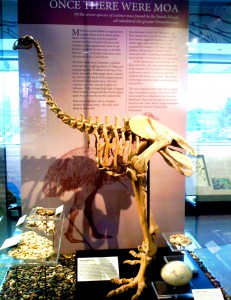 The moa was long extinct by the time Europeans settled New Zealand, but it is worth mentioning because it was so extraordinary. The giant moa was one of the largest birds the earth has ever seen, over three metres tall when it stretched up! It was flightless and heavy, like the kiwi only a lot bigger, with a long neck and a short beak. It was the only bird in the world to have no wings whatsoever – not even vestigial wings. It didn’t have a tail either. Despite its dominating appearance, it was a herbivore. It’s only predator – before the arrival of humans – was the terrifying Haast’s eagle. With its three-metre wingspan and claws as large as a tiger’s, the Haast’s eagle could well have hunted human beings along with the moa. It went extinct around the same time. The best place to find a moa is in a museum. Quite a few places around New Zealand have skeletons, including Dunedin Airport.
The moa was long extinct by the time Europeans settled New Zealand, but it is worth mentioning because it was so extraordinary. The giant moa was one of the largest birds the earth has ever seen, over three metres tall when it stretched up! It was flightless and heavy, like the kiwi only a lot bigger, with a long neck and a short beak. It was the only bird in the world to have no wings whatsoever – not even vestigial wings. It didn’t have a tail either. Despite its dominating appearance, it was a herbivore. It’s only predator – before the arrival of humans – was the terrifying Haast’s eagle. With its three-metre wingspan and claws as large as a tiger’s, the Haast’s eagle could well have hunted human beings along with the moa. It went extinct around the same time. The best place to find a moa is in a museum. Quite a few places around New Zealand have skeletons, including Dunedin Airport.
Article by Abigail Simpson, author of POMS AWAY! A British Immigrant’s View of New Zealand
Links to CC Licences:
https://creativecommons.org/licenses/by/2.0/
https://creativecommons.org/licenses/by-sa/3.0/deed.en
https://creativecommons.org/licenses/by-sa/2.0/
https://creativecommons.org/licenses/by-nc-sa/2.0/
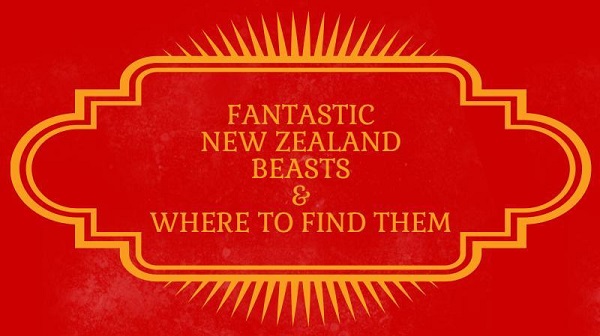
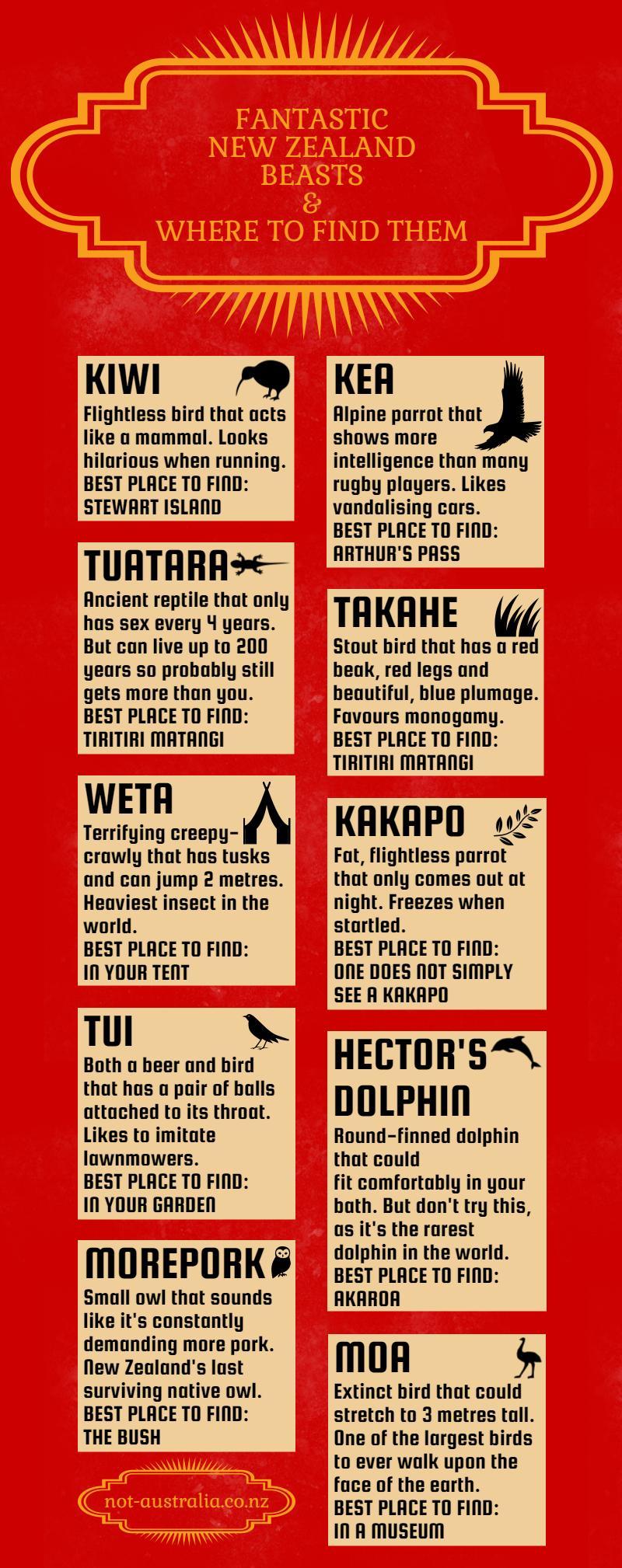
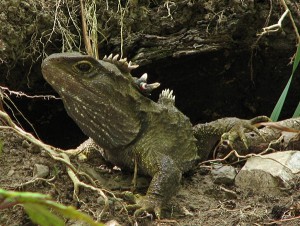
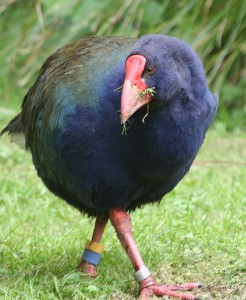
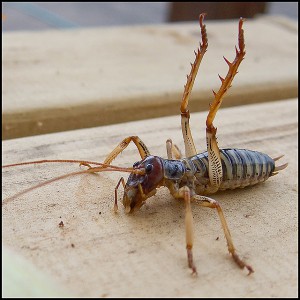
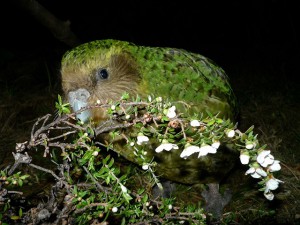
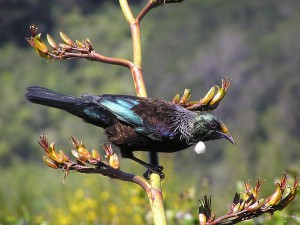
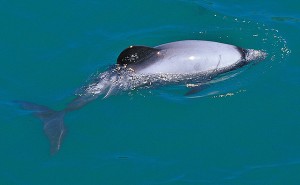
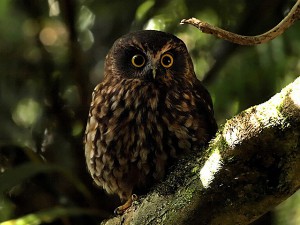

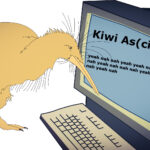
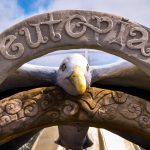
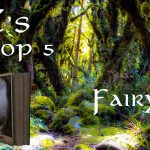
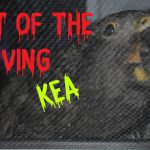
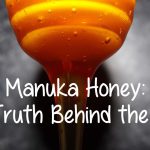

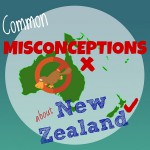
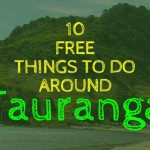

renanda tribowo
16th November 2019 — 1:29 am
is there at the zoo?